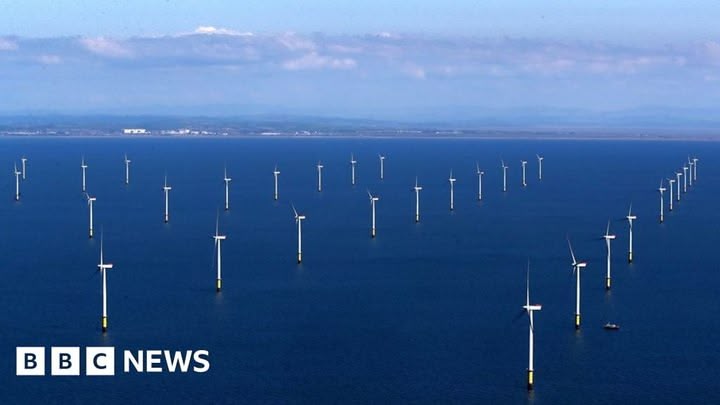What happens when wind turbines die of old age? Well, it’s not QUITE as a bad as nuclear reactors, but they're still going to cost “someone” billions
Photo above - unnamed offshore wind farm. 200-foot-long oceangoing tug at lower right shown for scale. After 25 years all these used blades are destined to become artificial reefs. Wait . . . did some worry wart just say "microplastics are infiltrating the food and water supply"? Can't be - wind turbines are safe, clean unlimited energy, right?
My father told me that (as a boy) the homes in his community started going all-electric. Because some guy from the electric company showed up and started telling everyone that "nuclear power will be so cheap we won’t even bother with meters anymore.” Then. a short while later, the full costs of constructing, operating, and then decommissioning nuclear power plants became apparent.
Are we headed down the same path with wind turbines? Forbes magazine (link below) has captured the scale of the problem but doesn’t pretend to predict the cost.
There are approximately 75,000 wind turbines in the USA. Yeah – that surprised me too. I would have thought that would mean electric power to spare. (one turbine for every 5,000 people?) Well, in any case, their operational life is 20-25 years. But some of these towers date back much further. To 1980, or earlier. Some have already stopped spinning. A few are actually decommissioned. It all depends on how your state and local government define decommissioned. Are the blades removed? The high voltage wires? How about the giant generator on top of the tower – what happened to that? Is the land underneath restored to something else? Farmland? A nature preserve? Replanted forest?
My mom used to live in a town which bragged about having America’s most famous paper mill. It was actually on Paper Mill Road. Beside a scenic stream where the paper oligarchs would dump their toxic waste after making the paper. That mill had been closed for a century by the time she moved there. But the building remained, rusting and collapsing. At one point the corpse of a murder victim was stashed inside. Local politicians finally bit the bullet and decided to remove what remained at taxpayer expense. It took over a decade. A local historic group got involved and insisted on preserving the 75-foot-high brick and stone chimney. Which stood like a towering an eyesore for another decade, before collapsing. Today the entire factory site is a parking lot.
Nobody is going to want a parking lot at the site of a decommissioned nuclear power plant, or a wind turbine, if that place used to be a remote cornfield or a prairie. And don’t get me started about decommissioning offshore windmills. Those things cost $2-$4 billion each to construct. Giant ships and cranes and helicopters will again be needed to remove each one of these. At which point the plastic/composite blades will be disposed of by . . . dumping them in the ocean. To form artificial reefs for fish. Because those blades won’t decompose in a landfill, and there aren’t enough landfills for 225,000 ginormous turbine blades (75,000 towers X 3 blades each) anyway.
A similar problem is starting to crop up with solar panels. They don’t live forever either. People with Solar City version 1.0 would like to upgrade to version 2.5, which is more efficient, durable, and might even blend in, rather than a looking like a mosaic of baking trays on the roof. Some solar installers will remove your old panels (at a slight additional charge) if you hire them to install the new improved version. Some won’t. Some other companies will remove them and (safely) recycle/dispose of the old ones, at a not-so-slight additional charge, if you can't sell a house with a non-working solar roof.
There are already companies springing up to recycle EV car batteries. The biggest one was founded by a former Tesla engineer. He saw this opportunity coming a mile away. Some day he may be richer than Musk.
Back to the turbines. And nuclear power plants. And failing hydro-electric dams. And every upcoming promise of infinite energy, perpetual motion, or the latest idea to solve all our energy problems. Fusion reactors. Tidal electric turbines. Geothermal (lava) production of steam. Giant mirrors and lenses to turn water into steam. Giant space mirrors to send concentrated solar rays to the concentrated points on earth’s surface. Giant blocks of recycled concrete hoisted on cables, which generate electricity as they slowly descend from their clockwork mechanism. Limitless hydrogen gas from limitless green ammonia. . . .
All of these will be more expensive than the numbers we’re being baited with today. Future "miracles" - like past ones - will be constructed with no plan for their inevitable decommissioning. Which will also be far more expensive than we imagine.
I’m NOT saying we should go back to burning wood and coal. But maybe we ought to rethink the idea that we can have unlimited electricity, along with unlimited population, unlimited AI, unlimited Bitcoin mining, etc. An ounce of efficiency might be worth more than a pound of cure.
I’m just sayin’ . . .
Hidden Costs, Rusting Relics: Decommissioning Wind Turbines In The US










